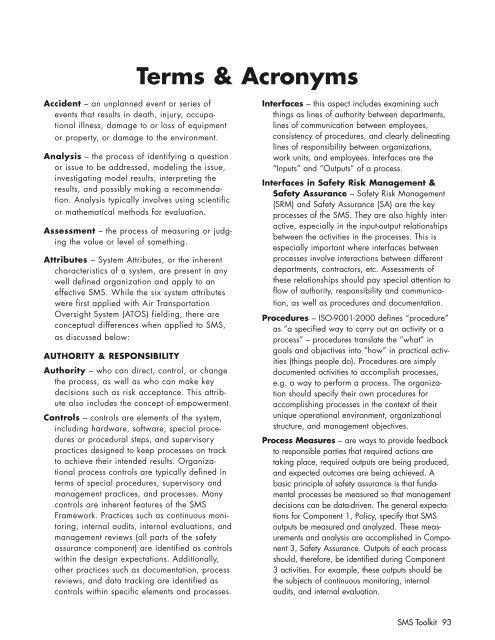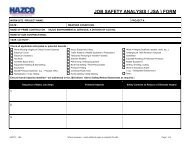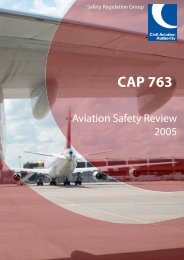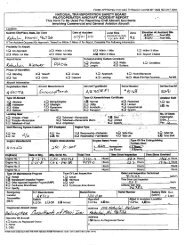International Helicopter Safety Team Safety Management System Toolkit
IHST - Safety Management Toolkit - Skybrary
IHST - Safety Management Toolkit - Skybrary
- No tags were found...
You also want an ePaper? Increase the reach of your titles
YUMPU automatically turns print PDFs into web optimized ePapers that Google loves.
Terms & Acronyms<br />
Accident – an unplanned event or series of<br />
events that results in death, injury, occupational<br />
illness, damage to or loss of equipment<br />
or property, or damage to the environment.<br />
Analysis – the process of identifying a question<br />
or issue to be addressed, modeling the issue,<br />
investigating model results, interpreting the<br />
results, and possibly making a recommendation.<br />
Analysis typically involves using scientific<br />
or mathematical methods for evaluation.<br />
Assessment – the process of measuring or judging<br />
the value or level of something.<br />
Attributes – <strong>System</strong> Attributes, or the inherent<br />
characteristics of a system, are present in any<br />
well defined organization and apply to an<br />
effective SMS. While the six system attributes<br />
were first applied with Air Transportation<br />
Oversight <strong>System</strong> (ATOS) fielding, there are<br />
conceptual differences when applied to SMS,<br />
as discussed below:<br />
AUTHORITY & RESPONSIBILITY<br />
Authority – who can direct, control, or change<br />
the process, as well as who can make key<br />
decisions such as risk acceptance. This attribute<br />
also includes the concept of empowerment.<br />
Controls – controls are elements of the system,<br />
including hardware, software, special procedures<br />
or procedural steps, and supervisory<br />
practices designed to keep processes on track<br />
to achieve their intended results. Organizational<br />
process controls are typically defined in<br />
terms of special procedures, supervisory and<br />
management practices, and processes. Many<br />
controls are inherent features of the SMS<br />
Framework. Practices such as continuous monitoring,<br />
internal audits, internal evaluations, and<br />
management reviews (all parts of the safety<br />
assurance component) are identified as controls<br />
within the design expectations. Additionally,<br />
other practices such as documentation, process<br />
reviews, and data tracking are identified as<br />
controls within specific elements and processes.<br />
Interfaces – this aspect includes examining such<br />
things as lines of authority between departments,<br />
lines of communication between employees,<br />
consistency of procedures, and clearly delineating<br />
lines of responsibility between organizations,<br />
work units, and employees. Interfaces are the<br />
“Inputs” and “Outputs” of a process.<br />
Interfaces in <strong>Safety</strong> Risk <strong>Management</strong> &<br />
<strong>Safety</strong> Assurance – <strong>Safety</strong> Risk <strong>Management</strong><br />
(SRM) and <strong>Safety</strong> Assurance (SA) are the key<br />
processes of the SMS. They are also highly interactive,<br />
especially in the input-output relationships<br />
between the activities in the processes. This is<br />
especially important where interfaces between<br />
processes involve interactions between different<br />
departments, contractors, etc. Assessments of<br />
these relationships should pay special attention to<br />
flow of authority, responsibility and communication,<br />
as well as procedures and documentation.<br />
Procedures – ISO-9001-2000 defines “procedure”<br />
as “a specified way to carry out an activity or a<br />
process” – procedures translate the “what” in<br />
goals and objectives into “how” in practical activities<br />
(things people do). Procedures are simply<br />
documented activities to accomplish processes,<br />
e.g. a way to perform a process. The organization<br />
should specify their own procedures for<br />
accomplishing processes in the context of their<br />
unique operational environment, organizational<br />
structure, and management objectives.<br />
Process Measures – are ways to provide feedback<br />
to responsible parties that required actions are<br />
taking place, required outputs are being produced,<br />
and expected outcomes are being achieved. A<br />
basic principle of safety assurance is that fundamental<br />
processes be measured so that management<br />
decisions can be data-driven. The general expectations<br />
for Component 1, Policy, specify that SMS<br />
outputs be measured and analyzed. These measurements<br />
and analysis are accomplished in Component<br />
3, <strong>Safety</strong> Assurance. Outputs of each process<br />
should, therefore, be identified during Component<br />
3 activities. For example, these outputs should be<br />
the subjects of continuous monitoring, internal<br />
audits, and internal evaluation.<br />
SMS <strong>Toolkit</strong> 93







